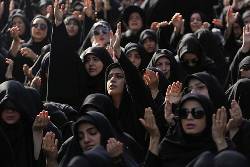TEHRAN, Iran (AP) — Iran’ s Supreme Leader Ayatollah Ali Khamenei on Saturday made his first public appearance since the 12-day war between Israel and Iran began, attending a mourning ceremony on the eve of Ashoura.
The absence of Khamenei during the war had suggested heavy security for the Iranian leader, who has final say on all state matters. State TV in Iran showed Khamenei waving and nodding to the chanting crowd as he entered and sat.
There was no immediate report on any public statement made.
Iran has acknowledged the deaths of more than 900 people in the war, as well as thousands of injured. It also has confirmed serious damage to its nuclear facilities, and has denied access to the sites for inspectors with the U.N. nuclear watchdog.
Khamenei hosted a remembrance of the 7th century martyrdom of the Prophet Muhammad’s grandson, Hussein, at a mosque next to his office and residence in the capital, Tehran. Iranian officials such as the Parliament speaker were present, and such events are always held under heavy security.
Shiites represent over 10% of the world’s 1.8 billion Muslims, and they view Hussein as the rightful successor to the Prophet Muhammad. Hussein’s death in battle at the hands of Sunnis at Karbala, south of Baghdad, created a rift in Islam and continues to play a key role in shaping Shiite identity.
In predominantly Shiite Iran, red flags represented Hussein’s blood and black funeral tents and clothes represented mourning. Processions of chest-beating and self-flagellating men demonstrated fervor. Some sprayed water over the mourners in the intense heat.
Israel relentlessly attacked Iran beginning June 13, targeting its nuclear sites, defense systems, high-ranking military officials and atomic scientists. In retaliation, Iran fired more than 550 ballistic missiles at Israel, most of which were intercepted, but those that got through caused damage in many areas and killed 28 people.
...


